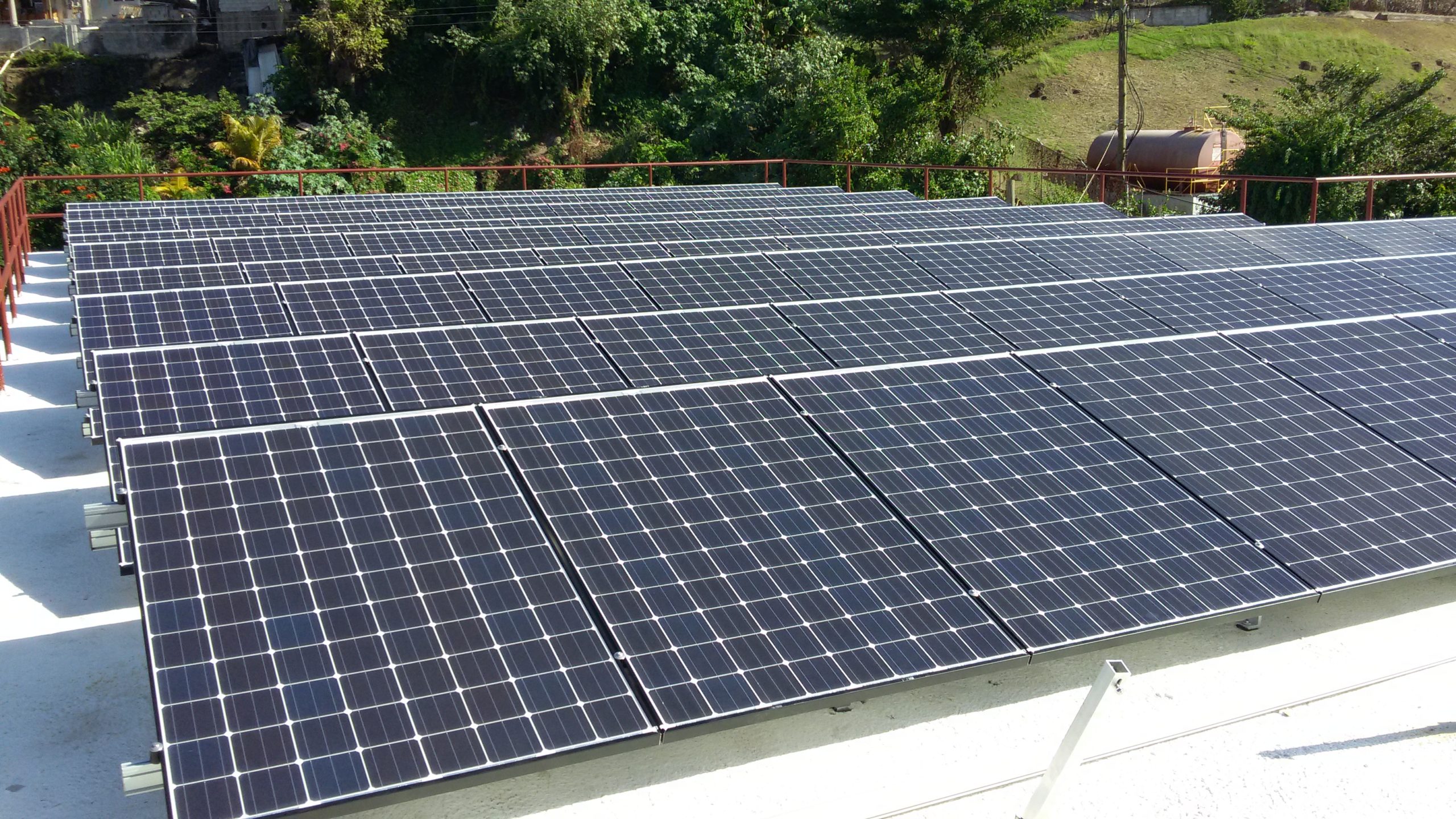Almost a decade after Dominica’s best and brightest recommended a diversified renewable energy plan, the island’s 75,000 residents are paying a high price for continued reliance on diesel-fueled generators to supply the electric grid. The current government has poured funds into a geothermal plant that would be capable of exporting electricity at a profit. But the project has stalled over costs and concerns about safety and it’s impact on the environment.
As a result, Dominica ranks as one of the countries whose people pay some of the highest energy rates in the World.
Prominent environmentalist Atherton Martin reflected on the public record for making the switch to non-fossil fuels saying “We are where we are: not in a good place.”
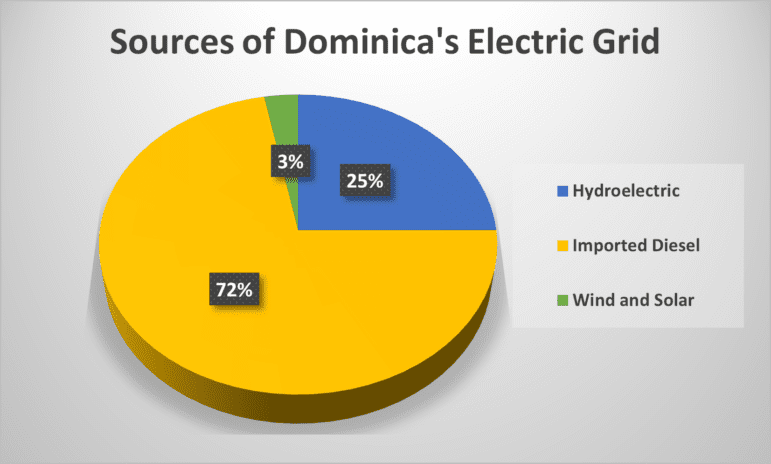
Martin, Dominica’s former Minister of Agriculture, placed the blame squarely on the government for ignoring the detailed Low Carbon Climate Resilient Development Strategy of 2012. That report was an in-depth study into the viability of renewable energy plants. It even identified where they could be located.
The report listed five renewable energy sources: Solar, Hydro, Wind, Geothermal, and Biogas – in that order – based on cost, timely construction, operation efficiency and maintenance concerns.
A Government Focused on a Single Source: Geothermal
Public records show the government of Dominica has spent more than $150 million dollars exploring Geothermal Energy for the past 12 years.
“That same amount of money,” says Atherton, “could have seen Dominica become completely dependent upon renewable energy, with wind on the East Coast, solar on the West Coast, hydro in the center of the island.”
“But we chose to ignore that advice,” laments Atherton, who has long been a thorn in the side of the government over environmental issues. He resigned from the government a year after taking office in 2000 after openly criticizing its official support for Japanese whaling. He accused the government of lending that support to Japan in exchange for benefits like free refrigeration units for storing fish.
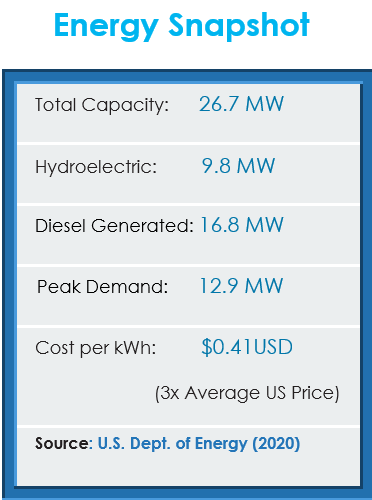
Prime Minister Roosevelt Skerrit has acknowledged delays in the geothermal energy project, blaming higher construction costs. Another impediment: resident concerns over safety and pollution.
But the continued reliance on diesel-power for electric generation is costing Dominicans dearly. The current (Oct. 2021) tariff is $1.16 EC…or 0.41 USD per kWh. That is three times the average rate paid by consumers in the U.S.
Sadly, the government silently declined our interview requests to discuss the slow progress of the Geothermal Project or the possibilities of other renewable energy projects. Numerous efforts were made to reach out to the Ministry of Trade, Ministry of Environment, and the Ministry of Green & Blue Economy. Despite our requests, the ministries did not share their current views or any statistical data.
It is a matter of public record, Dominica’s government favors a large geothermal plant that would not only fill the country’s energy needs, but create enough excess capacity to export electricity to Guadeloupe and Martinique.
Who’s Throwing Shade on Solar Power?
Businessman Herve Nizard insists the government of Dominica and stakeholders within the energy industry talk a lot about all forms of renewable energy but focus funding on only one: Geothermal. Based on the government’s actions, it has largely ignored investments in Solar and Wind Energy.
Nizard is owner of Sustainable Earth Inc., a well established company in Dominica offering consumers and businesses solar panels, batteries and the necessary hardware to make the switch from fossil fuels.
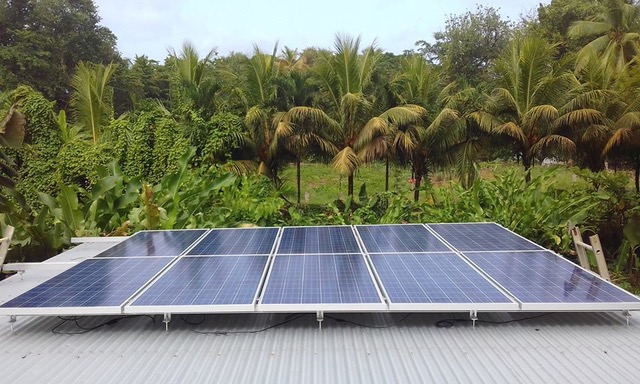
“If we take a picture of today (in Dominica,) all the elements are there for not promoting renewable energy,” insists Nizar. “Everything is made for it not to happen.”
As an example, Nizard points to so-called “Net Metering.” That’s when someone who has solar panels can sell back their unused energy to the grid during the daytime or exchange it for an equal amount of power at night.
“In Dominica, you buy from DOMLEC (Dominica’s privately owned, sole electric provider) at a rounded figure, let’s say at $1 per kilowatt, but they buy from you at 25 or 30 cents per kilowatt,” says Nizard.
If the government or DOMLEC were serious about promoting renewable energy, he insists, they would follow the example of other countries and buy back renewable energy at an even higher price instead of a discount.
Nizard points out that taxes also discourage the adoption of solar solutions. The Dominica government doesn’t charge DOMLEC customers VAT on the first 60 kilowatt hours of consumption, he told us. But the consumer installing a solar system is charged 15% value added tax on every single item imported for that installation. In that way, he argues, the government is actually discouraging consumers and businesses who want to “go green.”
Nizard also claims his customers are required to install “safety” equipment he considers unnecessary. It’s a requirement that further pushes the price of a solar installation higher and higher.
“DOMLEC is requiring a lot of technical things that should not be required, that are not required throughout the world, as added security. But these things add a big cost to any installation. It’s a bit like when you were importing your vehicle in Dominica the people at traffic were telling you, ‘Look, yes, I know your car has brakes, but I want you to add a big lever on the side of the car, so when you use your parking brake, you put that on the soil.’ But there is a parking brake. Why would you need that in addition?”
Officials at DOMLEC, Dominica’s sole Electricity Provider, denied they were trying to inhibit solar power. DOMLEC’s own Generation Manager, Dave Stamp, claims his engineers and technicians are enthusiastic about a transition from their generators that depend on costly imported diesel. (Stamp also noted that voicing support for alternative energy was official company policy.)
The building of a large scale Solar Power plant would mean jobs and profits if DOMLEC were invited to join in a partnership. But no such plans or a partnership are on the drawing board.
In his August 2020 address to Parliament on the budget, Prime Minister Roosevelt Skerrit said this:
“We are exploring the recommendations of the Sustainable and Resilient Energy Plan (S-REP) developed with the assistance of the Clinton Climate Initiative, with particular regard to the integration of large-scale solar PV to the national grid, on the west coast and the north of the island, and the creation of micro-grids.”
The S-REP plan was announced in 2019 but the whole concept of integrating a large scale solar photovoltaic generation plant has been talked about by politicians for more than a decade. “Exploring the recommendations” begs the question of just how much “exploring” needs to be done that requires more than a dozen years? Again government officials declined to discuss this.
Atherton Martin, winner of the prestigious Goldman Environmental Prize, noted the delays and said the “exaggerated timeframe, may be one of a lack of understanding or lack of proper administrative capability on part of the government of Dominica.”
Atherton insists sites for a major solar installation have already been identified. “I know that there are several sites that are suitable for solar that are large-scale.” he adds, “One is the Flat of Warner, another one is the Salisbury Flats another one is the flatish lands just before you get to Pickard going North in the Portsmouth area, and these areas are not just flat and hence amenable to the erection of multiple panels, but they are also facing in the correct direction you need to be facing in a southwesterly direction, to optimize the capture of sunlight from the sun based on where we are located in terms of latitude”
DOMLEC’s Dave Stamp noted that a large-scale solar project would face a number of challenges.
- Securing Sources of Funding for “High Capital Cost”
- Finding Skilled (Local) Labor to Carry Out Construction
- Securing a Knowledgeable Partner (DOMLEC) by reaching an agreement beneficial to all parties
“The other challenges that will be minor would-be local capacity, especially with a large solar project,” Stamp pointed out, “to execute not just a project of that size, but given that the technology would be new and the scope of it and so on, to ensure that we have the capacity and local resources, etc., in order to execute that kind of project.”
In Stamp’s view, any development of new energy sources should include DOMLEC as a major participant.
Well-known Dominican environmentalist, Father Franklyn Cuffy, Chairman of Waitukubuli Advocate for a Viable Environment (WAVE) was also keen to weigh in on the promises and challenges of a large-scale solar project. (Waitukubuli is a famous trail that cuts across miles of lush green forests on the island, through gorges, past waterfalls and volcanic craters.)
The Catholic priest agrees with fellow traveler Atherton Martin that Dominica can’t expect solar to provide enough energy to export. But he told us it is a practical way to cut back on the use of the fossil fuels (diesel generators) that provide the bulk of electricity on the island today.
Fr. Cuffy called upon Dominica’s Policy makers and Societal leaders to be more effective in achieving the goal of a 100% Renewable Energy rate by 2030. He even suggested the Catholic Church step up and help lead the way by installing solar solutions on its own properties.
He made a point of reference that regardless of the energy source utilized on the island, due to extreme weather conditions and its vulnerability to hurricanes, the cost of durable installation and maintenance must be taken into account.
Fr. Cuffy reflected on his shared experiences with managers of the Rosalie Resort, who installed a small wind turbine as a means of powering their property. Cuffy says the cost to maintain that single wind turbine was expensive – taking into account that it was placed near the sea where it endured constant salt spray.
He does note the wind turbine benefitted the Resort. It even generated more Electricity than what was needed, and as a result the Resort opted to sell excess energy to DOMLEC. The Rosalie Resort still boasts having the first wind turbine on the island.
Small-scale projects help wean the Nature Isle that is Dominica off its dependence on fossil fuels. But environmentalists, politicians, and voices in the energy industry agree small scale projects aren’t going to achieve 100% renewable energy by 2030.
Atherton Martin wasn’t denying it, but he was decrying years of time wasted and the tens of millions of dollars poured into developing a single resource.
In a frustrated-exhale, he concluded that the main culprit was the government’s singular focus on Geothermal Energy for the past 12 years. A focus that refused to envision how diversifying its 150 million U.S. dollar investment could have significantly boosted Dominica’s renewable energy rate to 90 or 100% – ending the country’s heavy reliance on Fossil fuels.
Dominica: Past and Future
Successive natural disasters including Hurricane Dean in 2007, Tropical Storm Erika in 2015, and Hurricane Maria in 2017 imposed devastating damage to the Commonwealth of Dominica’s infrastructure.
In 2015, the IMF estimated Erica caused $483 Million USD in damage. At the time, that was fully 96% of Dominica’s GDP.
Category 5 Hurricane Maria in 2017 was even worse. U.N. estimates of overall damage and losses were put at $1.3 Billion…or 224% of the island’s GDP at the time. Dozens of people lost their lives and about 90 percent of the country’s housing stock was destroyed. The National Electric grid was devastated and residents went without power for months.
It is apparent these successive disasters stalk the country’s economy to this day.
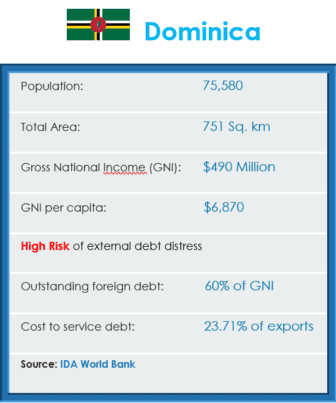
The cost of climate change has been on the nation’s balance sheet for more than a decade. It is a factor that the World Bank’s International Development Association classifies Dominica and its debt as being at “High Risk of External Distress.”
The latest figures published by the IDA show Dominica’s external debt being about 68% of its gross national income (2020.)
Dominica must pay the equivalent of almost 24% of its exports (goods, services and primary income) just to service that debt.
To further conclude, Caribbean Governments have all agreed that Caribbean nations contribute minuscule Carbon Emissions. In an address at the UN General Assembly Prime Minister Skerrit said while the big countries talk, the small island nations are suffering. He calls for action from developed countries.
“We as a country and as a region did not start this war against nature! We did not provoke it! The war has come to us!”
PM Roosevelt Skerrit Nov. 2017
This was four years ago and Dominica like other Small Island Developing States are still trying to hammer home that message. Dominica’s Minister for Environment did just that in Glasgow in COP 26 “Developed Countries need to assist Small Island Developing States (SIDS) to become resilient and sustainable. There is a moral obligation to do so. Climate justice demands it.” said Cozier.
It can’t be lost that Cozier was speaking before a hall which appeared half-empty. Who is listening to small island nations whose economies are repeatedly battered and whose residents are forced to bear burdens not of their own making?
A call to action is absolutely warranted. The politicians in Dominica need to hear that same message.
Clearly, because of the country’s financial situation, a major solar project will require significant economic and technical assistance from developed countries. Atherton and others believe that the Dominican government should be actively pursuing that instead of just talking about it.
And as Herve Nizard points out, there is a lot that the administration could do today to encourage individual homeowners, schools and businesses to adopt solar power and reduce the reliance on fossil fuel.
If Dominica is to live up to its name as “The Nature Island of the Caribbean” there has to be a greater sense of urgency at home and help from abroad.
